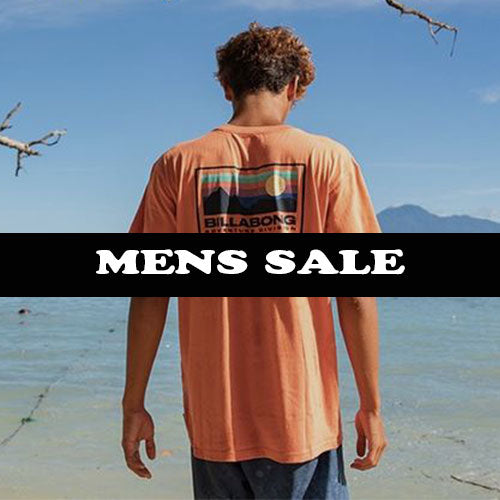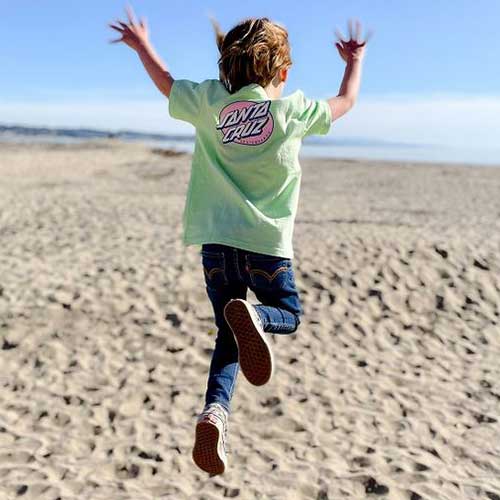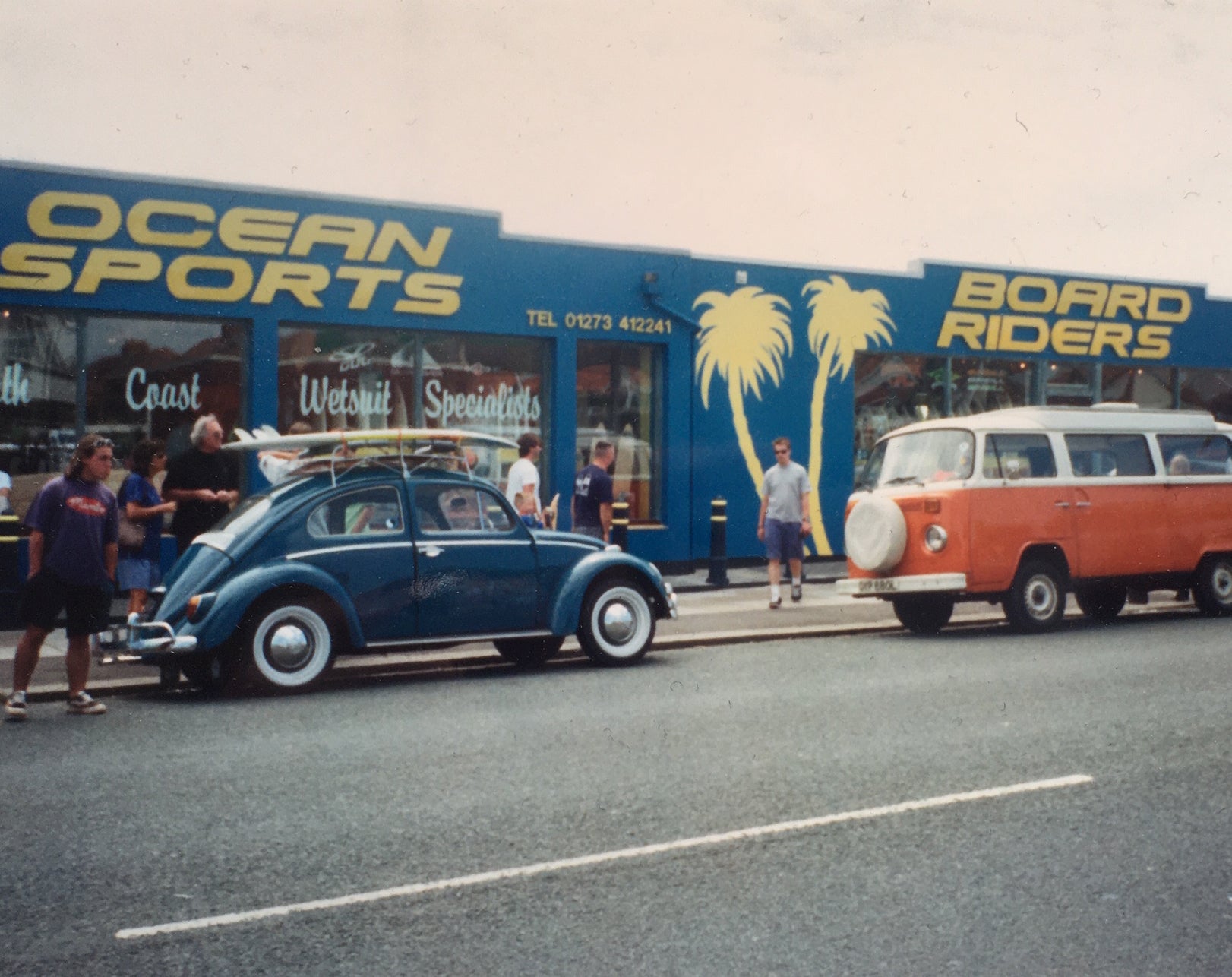Surfing Knowledge
What is a Surfboard?
Originally surfboards were made from wooden planks, they have come a long way since those Hawaiian surfs way back! Today surfboards are made by professional shapers by hand, out of foam with a fibreglass coating and designed to be light and strong. Shapes do vary and styles are always changing.
Different surfboards are suited to different wave conditions, rider ability and style. If you’re after advice about which kind of surfboard will suit you best, give us a call (01273 411141) and have a chat with someone from our friendly surf team.
What are the different parts of the Surfboard?
This diagram shows a standard surfboard and the various parts of the surfboard. The nose, rails, tail and stringer are part of every type of surfboard, whether it’s a shortboard, fish, retro, mini-mals & longboard. However the shape and style of these parts will vary.
The surfboard sits in the water deck side up and the nose of the board is the part that faces forward.
What is a surfboard deck?
The deck of the surfboard is the top side. This is where you stand to surf and lay on top of to paddle out. For extra grip on the surfboard deck, wax is applied to the surface. You’ll often see surfers with a deck grip (or ‘tail pad’) stuck to the board also. This gives greater grip and helps with foot positioning. We highly recommend you get a deck grip for your board – you’ll find it invaluable for control over the surfboard when you’re out in the water.
When looking at the deck of a surfboard you can usually see a slight camber from the rail to the middle, then from the middle back to the rail. This design is known as a ‘domed deck’ and it helps make rail-to-rail movements easier. You can also get a ‘flat deck’ which is, as you’d imagine, flat from rail to middle to rail.
What is a surfboard nose?
When riding, the nose of the surfboard sits out of the water. The shape of the nose varies depending on the type of board. A shortboard or fish board with usually have a pointed nose, while you’ll find a more rounded nose on longboards, fun boards and mini-mals. The nose is quite a delicate part of the surfboard and can be prone to dings. You can protect the nose of your surfboard with a ‘nose guard’ – which not only protects your board, but you as the surfer too, as a mistaken jab from the nose of your board can hurt a bit!
What is a surfboard tail & what are the different types of surfboard tail?
The tail of the surfboard is at the back of the board. A surfboards tail is extremely important and will dramatically change the way you surf. You can check out our guide or give us a call for general advice on which tail is better suited to which conditions. When choosing a tail design it really comes down to your individual choice and ability. If your friends have surfboards with different tails then it’s a great idea to try out their boards first and see what works for you.
There are a wide range of tails shapes including the squash tail, square tail, pin tail, thumb tail, rounded pin, baby swallow or low tail, the swallow tail, bat tails and winged tails. At first these can seem a little confusing but a surfboard shaper will apply the best-suited tail for the particular board they create, making a better-suited design for their clients. Each different shape of tail will give your board a different performance.
At the tail of the board you will also find a ‘leash plug’ which is where you attach the leash to your surfboard by looping it through.
The Squash Tail: The squash tail is the most popular design on modern day shortboard surfboard. The squash tail is a great ‘all-rounder’ that offers easy turning, smoother lines and an increased stability with take offs. The tail is suited for pretty much all wave conditions from medium sized to overhead.
The Square Tail: The square tail is not as popular as it once was and has seen a decline in numbers over the years. The main reason for this is that the square tail is made for a very specific style of surfing and offers fast drive when surfing. The sharp edge to the tail allows for quick and sharp rail-to-rail transitions and quick snaps whilst surfing.
The Pin Tail: The pin tail is often seen on gun style surfboards. This is because allows the surfer to get deep within the tube (of the wave) and the slightest movements become small smooth changes in direction. As you can imagine, the tube is not a place where you would want to catch your rail! The pin tail has a smooth rail to a pivotal point, which avoids nasty catches while giving a smooth yet effective ride.
The Thumb Tail: The thumb tail is a more rounded version of the squash tail and is often seen on surfboards like the Al Merrick Biscuits and more fun-shapes. The tail gives greater stability and a little drive to get you through those choppy slow sections. The rails on the tail are smooth allowing for rail-to-rail transitions and a smoother style. The best-suited waves for this tail are waist to head high or if the board has extra volume it could be ridden on smaller surf.
The Rounded Pintail: The rounded pin tail design is a mix between the thumb tail and the pin tail. This design is often seen on older shortboard styles and offers the benefits of both the thumb and the pin.
The Swallow Tail: The swallow tail design is often seen on fish style shortboards and is suitable in a variety of conditions, but will excel in choppy smaller surf. The wide tail will allow for a more stable and smooth ride while giving more volume to create a board that is easier to paddle and catch waves with.
The Baby Swallow Tail: The baby swallow tail combines the advantages of the swallow tail and the pin tail design. The surfboard tail often has medium rails to allow for quick but yet smooth directional changes. The narrow tail makes it perfect for tube positioning while the swallow allows for a smoother ride in choppy surf.
The Bat Tail: The bat tail design is like a small double swallow tail that channels water through the tail. This allows for greater stability and hold while you’re surfing. The bat tail is good in small to medium sized surf, but may struggle in larger surf due to its rail-to-rail transition.
What are surfboard rails & what are the different types of surfboard rail?
The edge of the surfboard is known as the rails. The rails run from the tail of the board to the nose and they are where the deck and bottom of the board meet. When surfing the surface of the rail is continually in the water and should not be overlooked when purchasing a board. The best rail for you will depend on the level of surfing you are at, where you surf, and the quality of the surf. The most common rails are full rails, also referred to as boxy or high rails, mid rails and low rails. Just as with tails, the different shapes will change the performance of your surfboard.
The Boxy High Rail: The ‘Boxy High’ rail is best suited to beginners to surfing, as it allows for greater flotation and stronger paddle power. In turn, this will make it easier for you to catch waves. The fuller rails also help to stabilise the board in choppy surf. The box rail is ideal for fat point-breaks or flattish beach breaks. When it comes to hollow waves the box rail doesn’t grip as well on the face of the wave or when carving and is therefore not really suited to performance surfing.
The Mid Rail: The mid rail is a cross between the low and high (box) rail. If you can only have one surfboard then have a board with mid rails as it is seen to be the best of both worlds. They have enough volume and drive to keep you going and a nice edge for carving. This style of rail can be applied to various wave conditions and is the best all-rounder.
The Low Rail: The low rail is a lot sharper and narrower on the sides. This increases in the board’s response and will effectively draw cleaner lines and hold better in the pocket. Because of the huge response of the rails, it is best suited to the advanced surfer.
What it the surfboard stringer?
The stringer of your surfboard is the strip that runs down length of the board, usually made of wood and designed to strengthen the surfboard. The stringer is already present in the surfboard blank before it is shaped. Softboards, Epoxy and carbon fibre surfboards often do not have stringers.
What are the different types of surfboard bottom?
The underside of the surfboard is known as the ‘bottom’. The 2 notable things about the bottom of your surfboard are the fins, and the contour of the board. There are a number of different contours to consider, again like with rails and tails, the bottom contour will change the performance and give different characteristics to your board. Some boards will have single or double concaves, while others are flat or channelled. On the whole, the more water that channels through the board, the greater your stability. You can check out our guide to the main types of bottom contours, or feel free to give our surf team a call for advice on 01273 420142.
What is surfboard rocker?
The surfboard rocker refers to the natural curve in the board from the tip of the nose straight through to the tail.
The best way to determine the amount of rocker in a board is by laying it flat on the ground. This way you will be able to see the natural curve that the board makes. This curve is referred to as a board’s rocker.
The larger or more curved a surfboard is, the greater the turning abilities when you’re in the pocket of a wave. A greater rocker is generally suited for cleaner larger waves, while a flatter rocker is more suited to full fat waves, where it will fly like a rocket! The only downfall to a flat rocker is that the board is harder to manoeuvre when you’re on suckier, more curved waves.
What are the different types of surfboard?
Longboard Surfboards
A longboard surfboard is often referred to as a Malibu Surfboard. The Malibu boards range from anywhere between 8 – 14 feet and are often very wide with large volume.
In terms of correct sizing it is best to get a board that is around three feet taller than yourself.
The added length and volume make the longboard the ideal surfing companion, as catching waves can be a breeze! The flat bottom of the board will allow you to be propelled in small surf deemed impossible to surf on a shortboard surfboard. The width of the board will allow for greater stability and a smoother ride. Because of this most beginners are attracted to the long-board style of surfing. The longboard surfboard is not only for beginners - advanced surfers will ride the nose of the board and turn the board, completing difficult and impressive manoeuvres when surfing.
Many traditional surfers like the Malibu board as it allows for smoother turns and greater style and a more natural feel to the sports history. Throughout the years the boards have progressed in materials from original balsa wood to fibreglass models and now the Tuflite technology.
Over the years the longboard has been altered and changed to suit every style and level of surfing. The basic single fin design is seen on most boards however as the sport has progressed we have seen both the tri fin models and the 2 1 models hit the market.
A tri-fin model literally means the board has 3 fins. Sometimes they are of equal proportion, while others have slightly longer middle fin. The benefits of the tri fin set-up are that the board is able to turn with greater ease and will have more drive through the water.
The 2 1 fin set-up is favoured amongst the older style with a bit of the new thrown in. With this model the surfer is able to ride with one fin (older style) or simply add the two smaller side fins to allow for greater turning. The 2 1 set-up also allows for the surfer to nose ride the board. As you could image with only three short fins (tri-fin set-up) the rider may go to nose ride and spin out of control. The reason for this is because if the tail of the board lifts up (as will the fins) there will be nothing in the water (fins) to control the direction of the board.
Retro Surfboard Shapes
Retro shapes often refer to boards like the fish, single fin shortboards, twin fins, quad fins, eggs and Al Merrick Pods and Biscuit surfboards (or generally shapes that represent an alteration of the shortboard design).
Some of these shapes are extremely underrated while others are better suited for a specific style of surfing. The fish board for example has a flatter bottom and rocker to allow the board to glide across flatter and choppier sections. Pretty much all fishboards will have a swallowtail. The swallowtail is usually wide allowing for greater paddling power and stability whilst having an increase in drive in smaller and less powerful waves. The fish board is a must for any UK surfer as UK waves conditions match the board’s ability.
The egg surfboard is a shortboard that has a huge amount of volume and width. The nose on these boards remains narrow and the tailis usually round. The advantages of these boards are that you will have a lot more paddle power while surfing and because of the increased paddle power it will be easier to catch waves.
The majority of the retro designs offer large volume and width and are often seen in classic surf movies like Endless Summer and Endless Summer 2.The retro board is ideal for defining your style as it allows for smooth turns and a more relaxed ride.
Boards like the Al Merrick Pod and Biscuit are newer designs that are gaining more and more favouritism amongst surfers. These boards are perfect for UK waters as they are full of volume and have enough width and drive for smaller and choppy waves. Places like Australia, South Africa, New Zealand and the USA have high salt density in the water. This will increase your flotation in the water and is why you may find thinner boards work better in these locations. For the UK we advise you purchase a board with a bit more volume then the ones found in the above countries. If in doubt, give us a call and a member of our surf team will advise you (01273 420142).
Mini Malibu Surfboards
The Mini Malibu (mini-mal) surfboard or fun-shape is a smaller more defined version of the original Longboard Malibu style surfboard. You’ll find the mini-mal to be around 6’5 to about 8’0 in length.
The smaller lengths are often large in volume, allowing for greater paddle power and have a standard longboard width that allows for an increase in stability. 90% of the time the ‘Mini Malibu’ will have a tri fin set-up. As you’d expect, a tri fin model means the board has 3 fins. Sometimes they are of equal proportion, while others have a slightly longer middle fin. The benefits of the tri fin set-up are that the board is able to turn with more ease and have more drive through the water.
Advanced technologies coupled with a progressing sport have created various types and constructions of the Mini Mal surfboard. The original fibreglass design is still seen as a favourite amongst intermediate to advance surfers. An advantage of the fibreglass design is that if it gets damaged, the surfboard can be easily repaired. However the disadvantage of a fibreglass board is that it’s likely to get glass cracks and once damaged open holes may disintegrate the blank of the board, leaving you with a yellow waterlogged piece of junk. The alternate constructions include plastic CTS and Tuflite technology.
Plastic CTS styles often found in BIC surfboards are great for beginners as they can handle an absolute beating and provide piece of mind for beginners. The disadvantages of these boards are that they are slightly harder to turn and do not seem to go as fast as their fibreglass cousins. However if you are new to the sport and only want to go a few times a year then the BIC is a perfect option.
The Tuflite technology is harder then a fibreglass board and will therefore go faster and handle those little bumps. To find out more about Tuflite construction you can check out our guide.
The mini-mal surfboard is great for beginners as it has all the advantages of the Malibu but without the cumbersome length of the longboard surfboard. Also once a beginner is comfortable with this style they can then choose to go shorter in length and try short-boarding or go even longer and try the original Malibu surfboard style. More advance surfers still continue to surf these boards as they provide fun and inspiration for all ages and levels of surfing
Shortboard Surfboards
The shortboard has been around now since the 60’s revolution that seen an increase in technology and a decrease in board length. Since then the boards have been re-shaped redefined, and have now become the core board to surfing. Shortboard surfboards are not recommended for beginners as they are harder to paddle, harder to stabilise and you will need fair to good waves to be able to ride one. Often beginner surfers want to purchase this style of board because they have seen the pro’s riding them or are influenced by glossy magazines, but we advise against this. If you’re a beginner we recommend you first try a mini-mal or longboard style of surfboard, as they are easier to control. Once you’ve got the hang of it, then move on to something shorter. Surfing takes patience, time and years to master, so it’s better to have a board you can work with rather than get frustrated and throw in the towel!
For those of you who are advanced enough to ride a shortboard the advantages are quicker turns, sharper bottom turns, greater agility and you’ll find it easier to duck dive. As a shortboard surfboard rider you will define your skills and instinctively know when to use the shortboard and when to use a mini-mal or a retro shape.
Shortboards come in slightly different styles and are often found with different tails, rails, bottoms and rockers. For more information about these technical parts please see their sections.
The shortboard surfboard leash and deck-grip are frequently underrated when surfing. If you don’t have a deck grip (tail pad) then we highly recommend you purchase one. The deck grip allows for a surfer to place his/her foot directly above the fins and by doing so gives complete control over the board. You may have seen people place their back foot too far forward and so they go to do a bottom turn, buy continually slide out or loose control of the board! This is often because their foot is not in the correct position on the board and when attempting to turn, they are unable to.
Shortboards these days are made from both fibreglass and resin or made with advanced construction like Tuflite technology or epoxy (plastic resin). If you require more information on any of the above information then please get in touch with us.
If you are unsure as to what type of surfboard you are after then it is best not to go too large in length. Often beginners are too keen to start surfing and focus purely on standing up. Although standing up is an amazing feeling, you should also consider things like your bottom turn and getting out the back to the line-up. If your board is cumbersome in size then you will find turning harder and getting out the back difficult as you cannot duck dive a longboard surfboard. The best way to avoid this is by what is known as the ‘turtle roll’. When trying to get out the back, hold onto your rails and then roll over onto your back. The science behind this is that when you roll over, the weight of your body will hold the board in place and then the white wash will pass over the top. Once passed, paddle as hard as you can out the back and repeat this process when necessary.
What is a Tuflite surfboard?
TUFLITE is the product of over 15 years of science focused on one goal; build the toughest, lightest, most responsive surfboards in the world. The Tuflite coating on a board means it can withstand much more of a beating than a fibreglass board that is delicate and prone to dings. You will also find a Tuflite surfboard to be more buoyant in the water.
Surftech say: “Tuflite construction offers the most advanced quality construction suitable for the spectrum of surfboard models. Using only the highest quality EPS foam, epoxy and fiberglass materials, Tuflite surfboards are composite sandwich boards that boast the ultimate combination of performance and durability. Built off a shapers most renowned shape, each Tuflite represents the highest quality surfboard in its respective range. Working with nearly every major shaper in the world insures that Surftech offer the optimal choice for every surfer in the water today.”
“Today Surftech's shapers driven TUFLITE models are the number one selling range of boards in the world. Surfers world wide have realized that a Tuflite board in their quiver means that they have guaranteed performance, anywhere in the world at any time; shaped by a designer that they know and trust. The creation of each Tuflite board is a technical design achievement unrivaled in the surf industry.”
How are Tuflite surfboards constructed?
Sandwich Construction: By using specific layers of materials, the boards achieve performance while creating an incredibly durable and extremely lightweight board.
Multiple Epoxy Layers: 2 completely separate layers of quality epoxy/fiberglass lamination
High Density Foam Wrapped Rail: Similar to the glassing process, wrapping our exterior foam around the rail provides strength, eliminates "splitting" and improves longevity of your board.
If you are unsure about whether to go for a Tuflite board and would like a chat with an un-biased member of our surf team, give us a bell on 01273 411141 and we’ll be happy to advise.





